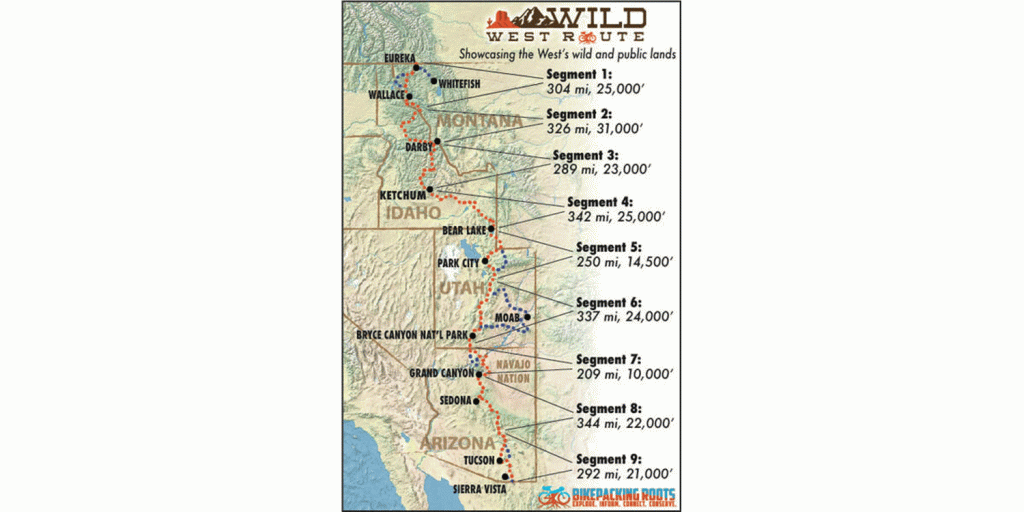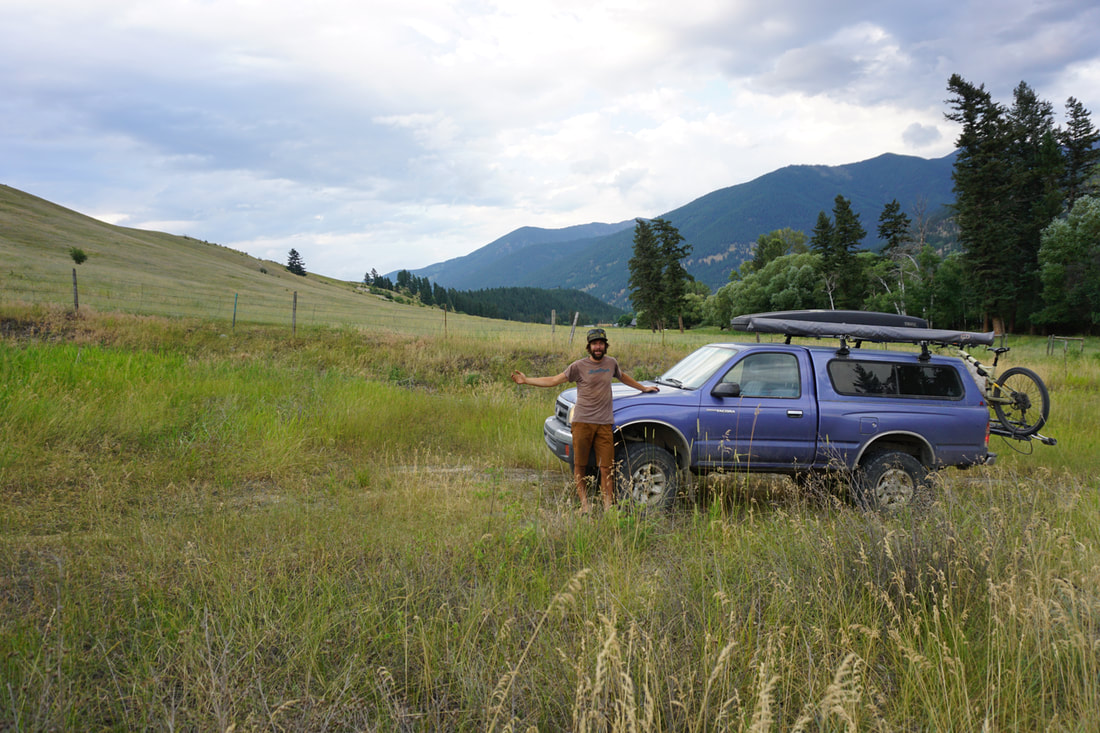Kurt Refsnider has ridden through the night as much anyone in the sport of ultra-endurance mountain bike racing. He has pushed himself for days on end: six straight in 2018 to set a new course record on the 750-mile Arizona Trail Race and just under 16 in 2011 when he won the 2,745-mile Tour Divide. He’s also explored swathes of the world by bike, forging a 900-mile route through Patagonia in a month in 2017 and riding 800 miles across three countries in the European Alps in 2014.
So it’s a little startling when Refsnider said that the five-week stint he spent reconnoitering the new Wild West Route (WWR) bikepacking course—by pick-up truck—was among the hardest things he’s done.
“When I started, I didn’t think it was going to be hard,” Refsnider said. “By the finish, I was sweaty and dirty and sleep-deprived and surprised at how exhausted I was.”
Announced in April, the Wild West Route is a 2,700-mile, mostly dirt-road cycling course that bisects the United States from the Mexican border near Sierra Vista, Arizona, to the boundary with Canada just outside of Eureka, Montana. The route is the flagship achievement of Bikepacking Roots, a not-for-profit advocacy group founded by Refsnider and Kaitlyn Boyle in 2017. In addition to the WWR, Bikepacking Roots has established three other shorter courses in the western U.S. and it has several more projects in the works.

Refsnider, who worked as a geology professor at Prescott College for years before going full-time as an athlete and cycling spokesperson, created the organization to meet the swell of interest in bikepacking. “This community has grown so quickly, but there’s been no one advocating for it,” he said. Per Boyle, also a racer and advocate, their organization stretches well beyond simply mapping cool routes like the WWR. “With so much growth comes huge opportunity to shepherd a responsible user group, develop routes intentionally and help bikepackers have a role in conserving the landscapes they ride through,” she said.
Nearly 70 percent of the route lies on public lands, passing through four states, 18 national forests, six national parks and monuments, four BLM national conservation lands, and two tribal parks. And, with the exception of a couple of day-use and overnight camping permits, it’s free to traverse.
“I know from personal experience how transformative a ride like this can be, and I also believe that helping people to have such an experience on public lands is one of the best ways to get them invested in these resources,” Refsnider said. “So yeah, the WWR is a giant way to showcase public lands and, in the long run, hopefully help keep wild places wild.”
Not to be confused with the Great Divide Mountain Bike Route (GDMBR), the basis for the annual Tour Divide race, the Wild West Route sits farther west, running through Utah and Arizona as opposed to Wyoming, Colorado and New Mexico, and is a predominantly northbound complement to the GDMBR’s largely southward flow.
The popularity of the GDMBR was one motivation for the Wild West Route.
“So many riders have traversed the Tour Divide, and it has been life-changing for many of them,” said Refsnider. “There was a definite desire for another long and challenging route.” Whereas only 16 people lined up for the premiere grand depart of the Tour Divide in 2008, nearly 200 riders took part in this year’s race.
“It was conceived as a means of taking participation pressure off the GDMBR,” said Matthew Lee, de facto organizer and three-time winner of the Tour Divide, who had early input on the WWR. The evolution of bikepacking was also a driving factor. “As equipment has improved, speeds and daily averages on the Tour Divide have gone up, and I think many of us were longing for less-traveled two-tracks,” he added.
While Refsnider stresses that the WWR is non-technical and accessible to bikepackers of different skill levels, he allows that resupply points are fewer and farther between than on the GDMBR, and that the terrain is more challenging. “Fast riders go out expecting to do 200-mile days on the GDMBR,” Refsnider said. “On this route, you’ll be doing well to get 50 to 70 daily.”

The Wild West Route traverses the Snake River Plain in Idaho. Photo Credit: Kurt Refsnider
Split into nine segments of around 300 miles, the WWR’s biggest appeal is its geographic diversity and wild feel. From the steep and lush mountain canyons of Montana and Idaho to the high plateaus of Utah and the parched grasslands and deserts of Arizona, 80 percent of the route is off pavement, largely on dirt roads and 4×4 tracks. Most of the segments have climbs of 3,000 and 4,000 feet, with some even bigger. Surfaces tend toward rocky and loose and are best suited to mountain bikes.
The itinerary is built around small communities, including a specially negotiated 100-mile stretch that provides a rare opportunity to traverse a portion of northern Arizona’s Navajo Nation (backcountry permits required). The towns along the way make travel easier, though stretches of 50 miles between water and 90 miles between food resupply points are common. On one especially dry section in Arizona, it’s 95 miles between water sources, a distance which could take riders two full days pedal.
That might sound daunting, especially to those uninitiated in the sport, but Bikepacking Roots has a trove of information to ease the task. The organization provides a complimentary download of the high-res GPS route file for all of its 4,000 members; joining the group is free. It has also published an 82-page PDF guidebook which details water stops, campsites, resupply points, hotels, bike shops and medical facilities, and includes a vast overview of the trail’s history, geography, weather and packing tips. There are also suggestions for shorter sections.
“Not everyone has months to devote to a bike ride,” said Refsnider. “But that doesn’t mean you can’t get out and experience the Wild West Route.”
A print edition of the guide will be available later this summer, and there’s even a GPS-enabled app so riders can access all the minutiae in real time. “We wanted to remove the logistics as a barrier,” said Refsnider.
If riding the WWR sounds challenging, creating the route was more so. What started as an idea kicked around among Refsnider, Lee, Boyle and a handful of other bikepacking junkies morphed into a loose collective groundwork and then, after days and months of poring over Google Maps, a rough schematic. Once the general route was set, taking into account which target communities, national parks and public lands to pass through, Refsnider set out in June 2017 in his 2000 Tacoma to hone the details.
For most of the journey, he had two or three side-by-side options to explore. “I’d often get deep into the backcountry and not know if the route would go through, or whether the road would be impassable and I’d have to turn around and possibly run out of gas,” he said.
The closest he came to disaster was scouting the Skyline Drive section in northern Utah, where he tried to skirt some snowbanks and felt the road giving away beneath him. He gunned it and made it through, but the experience drove home his isolation. “My bikes were the escape plan. I figured I could always pedal out if something went wrong,” he said. “But I’d never considered actually losing the vehicle with the bikes.” In five weeks, he covered some 6,000 miles.

Doing reconnaissance to develop the Wild West Route. Photo Credit: Courtesy of Kurt Refsnider
After the reconnaissance mission, Bikepacking Roots recruited 40 volunteers to ride stretches of the new route and flesh out the cycling-specific details. Most committed to partial stints, but two volunteers, Clee Roy and Samuel Schlicht, independently rode the entire course before its release.
Shlicht, who traveled from his home in Germany, tackled the WWR in 8 weeks. “It was a great challenge for me to ride in a foreign country, through landscapes I’d never experienced. I’d never been in a desert before that and never had to deal with wildlife like cougars or bears,” he said, adding that Americans should take pride in the route. “Riding the WWR is a way for everyone to help protect and conserve these public lands. These are some of the last wild places in the U.S.”
